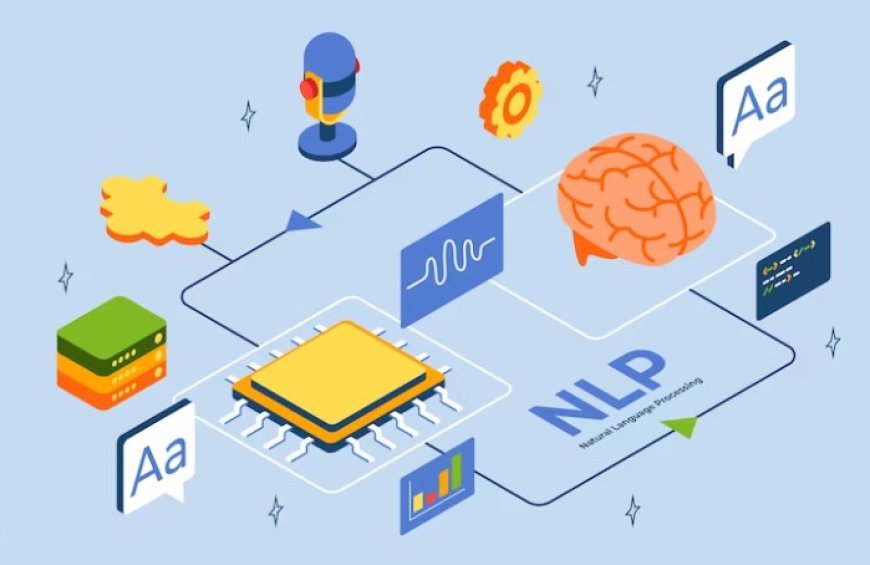The Role of Natural Language Processing (NLP) in AI Applications
Explore how NLP revolutionizes language understanding and communication in various fields, from chatbots to sentiment analysis and beyond.

In the realm of AI, Natural Language Processing (NLP) is the pivotal technology that enables machines to understand, interpret, and generate human language. Its significance lies in its ability to bridge the communication gap between humans and machines. NLP empowers AI applications to process, analyze, and respond to natural language, making it a fundamental component in various domains, from chatbots and virtual assistants to sentiment analysis and machine translation. This introduction sets the stage for exploring how NLP plays a vital role in shaping AI applications.
Foundations of NLP
Linguistic principles are at the core of Natural Language Processing (NLP). Understanding syntax, semantics, and pragmatics enables NLP systems to decipher language nuances. This knowledge helps in tasks like parsing sentences, identifying entities, and extracting meaning from text.
Data preprocessing and tokenization are crucial steps in NLP. Raw text needs to be cleaned, standardized, and organized for effective analysis. Tokenization involves breaking down sentences into smaller units like words or phrases, allowing algorithms to process language effectively.
Key NLP libraries and frameworks provide the tools necessary for building NLP applications. Libraries like NLTK, SpaCy, and frameworks like TensorFlow and PyTorch offer pre-built functions and models, expediting the development process and ensuring robust NLP solutions.
NLP Techniques and Components
Natural Language Processing (NLP) encompasses a range of techniques and components that enable machines to process and understand human language. This includes text classification and sentiment analysis, which involve categorizing text into predefined classes and discerning emotions or opinions expressed. Named Entity Recognition (NER) identifies and extracts specific entities like names, locations, and organizations from text. Part-of-Speech (POS) tagging assigns grammatical labels to words, aiding in syntactic analysis. Additionally, dependency parsing establishes relationships between words in a sentence, crucial for understanding sentence structure. Machine translation and language generation are pivotal in tasks like automatic translation and content creation, respectively, demonstrating the diverse capabilities within NLP. These NLP techniques and components form the core building blocks for a wide range of AI applications, facilitating natural language understanding and generation.
NLP Models and Frameworks
Natural Language Processing (NLP) has seen a significant boost in recent years thanks to the emergence of powerful pre-trained models like BERT (Bidirectional Encoder Representations from Transformers) and GPT (Generative Pre-trained Transformer). These models, with their massive neural architectures, have demonstrated remarkable capabilities in understanding and generating human-like text.
Training and fine-tuning NLP models is a critical aspect of their utility. During training, these models are exposed to vast amounts of text data to learn language patterns and semantics. Fine-tuning involves adapting these pre-trained models to specific tasks, making them versatile for various applications, from sentiment analysis to language translation.
Transfer learning is a core principle in NLP. It allows the knowledge acquired by a model from one task or domain to be applied to another. This approach significantly reduces the need for extensive labeled data for each new task, making NLP more accessible and efficient. Transfer learning has opened doors to rapid advancements and innovations in the field, making NLP a pivotal technology in AI applications.
NLP in Real-World Applications
NLP plays a pivotal role in numerous real-world applications, demonstrating its versatility and impact in various domains:
-
Chatbots and Virtual Assistants: NLP enables the development of intelligent chatbots and virtual assistants that can understand and respond to human language. These AI-powered agents are used in customer support, e-commerce, and even as personal assistants, enhancing user interactions and efficiency.
-
Sentiment Analysis for Customer Feedback: NLP algorithms analyze textual data from customer reviews and social media to gauge sentiment. This helps businesses understand customer opinions, identify trends, and make data-driven decisions for product improvements and marketing strategies.
-
Machine Translation in Global Business: NLP-driven machine translation tools bridge language barriers, facilitating global business operations. Companies use these tools for translating documents, websites, and communication, enabling cross-border collaborations and expanding market reach.
-
Healthcare Applications (Clinical NLP): In the healthcare sector, clinical NLP is employed to extract insights from medical records, patient histories, and research documents. This aids in diagnosis, treatment recommendations, and medical research, improving patient care and outcomes.
-
Legal and Regulatory Compliance: NLP assists legal professionals in sifting through vast volumes of legal documents, contracts, and regulations. It helps identify relevant information, analyze risks, and ensure compliance with complex legal requirements, saving time and reducing legal risks.
In these applications, NLP leverages its ability to process and understand human language to enhance efficiency, decision-making, and user experiences across various industries.
Ethical Considerations in NLP
-
Bias and Fairness in NLP: Ethical concerns arise due to biases present in training data, which can lead to discriminatory outcomes in NLP applications. Addressing bias requires data preprocessing, fairness audits, and transparent algorithms to ensure equitable results for all user groups.
-
Privacy Concerns: NLP often involves processing personal or sensitive information, raising privacy issues. Ethical NLP applications must prioritize data protection, implement encryption, and adhere to regulatory frameworks to safeguard user data.
-
Responsible AI Practices: Ethical NLP practitioners must follow responsible AI guidelines, promoting transparency, accountability, and user consent. Continuous monitoring and feedback loops help mitigate ethical risks and ensure responsible NLP development and deployment.
Challenges and Limitations
-
Ambiguity and Context Understanding: One of the primary challenges in NLP is dealing with the inherent ambiguity of human language. Words and phrases can have multiple meanings depending on context, making it difficult for AI systems to accurately interpret and respond to user input. Developing models that can understand context and disambiguate language is an ongoing challenge.
-
Bias and Ethical Concerns: NLP models can inadvertently perpetuate biases present in training data, leading to unfair or discriminatory outcomes. Addressing bias in NLP algorithms and ensuring ethical considerations in data collection and usage is critical to prevent unintended harm and promote fairness.
-
Multilingual and Low-Resource Languages: While NLP has made significant progress in widely spoken languages, it still faces hurdles in less common or low-resource languages. Building robust NLP models for diverse languages and dialects remains a challenge, limiting the accessibility of AI technologies to a global audience.
-
Scalability and Processing Speed: NLP models, especially large-scale ones, demand substantial computational resources, making them less accessible for resource-constrained environments. Improving the scalability and processing speed of NLP models to accommodate real-time or edge computing applications is an ongoing concern.
Addressing these challenges is crucial for the continued advancement and ethical use of NLP in AI applications.
Recent Advances and Future Trends
Transformers and Pre-trained Models: Recent years have witnessed a transformative shift in NLP with the introduction of transformers and pre-trained models like BERT, GPT-3, and T5. These models have significantly improved natural language understanding and generation tasks, paving the way for more accurate and context-aware AI applications.
Multimodal NLP (Combining Text and Other Data): The future of NLP extends beyond text to incorporate multiple data modalities, such as images, audio, and video. Multimodal NLP research aims to develop models that can understand and generate content across diverse data types, enabling richer and more immersive AI experiences.
Explainable AI in NLP: Ensuring transparency and interpretability in NLP models is critical. Researchers are actively working on techniques to make NLP models more explainable, allowing users to understand how decisions are made and building trust in AI applications.
NLP in Edge Computing and IoT: As computing resources become more distributed, NLP is moving towards edge devices and the Internet of Things (IoT). Implementing NLP at the edge enables faster responses, reduced latency, and privacy-preserving AI applications, making it a promising frontier in the field.
These recent advances and future trends in NLP signify its continuous evolution, offering the potential for AI applications to become more versatile, accessible, and accountable in various domains.
Natural Language Processing (NLP) plays a pivotal role in AI applications by enabling machines to understand and interact with human language. Its significance is bound to grow further, with continuous innovation and advancements. As NLP technologies evolve, we anticipate even greater integration into various industries, revolutionizing communication between humans and machines. This dynamic landscape promises a future where NLP-driven AI systems will become even more integral in shaping how we interact with technology and information.




























































